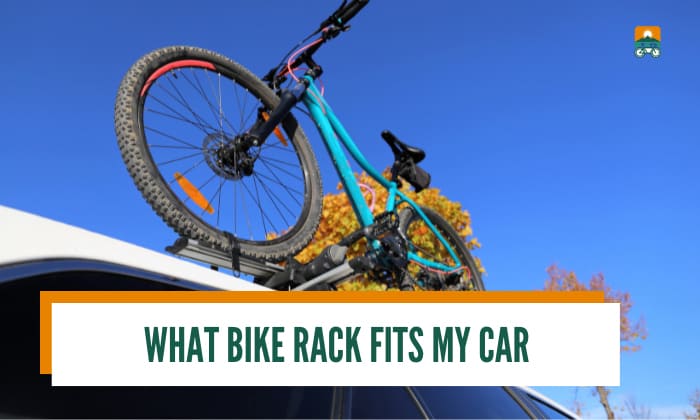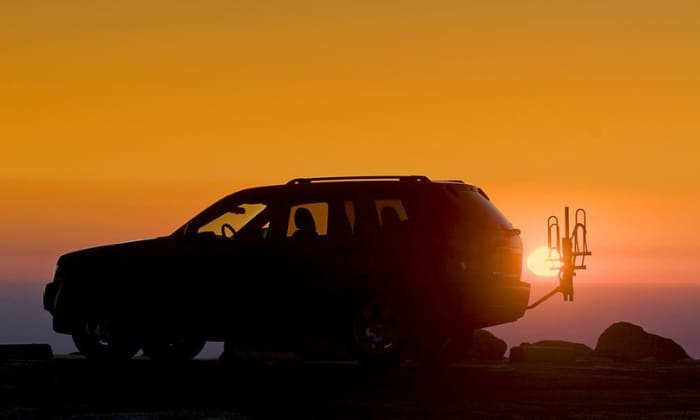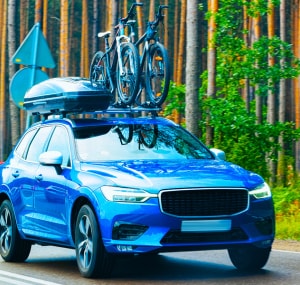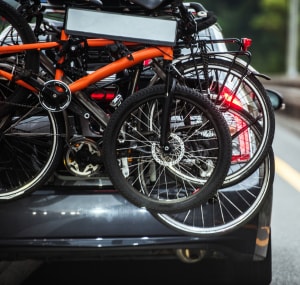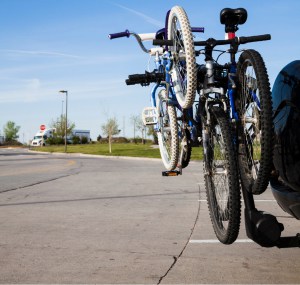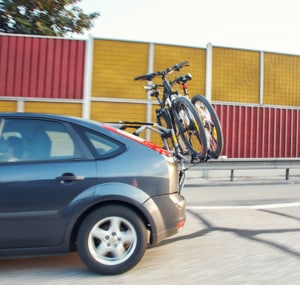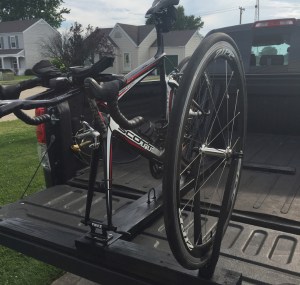Bike racks are necessary for transporting a bicycle, especially if you have more than one. However, you will need to consider and answer a very important question: What bike rack fits my car?
There are many bike rack types, but not all work with any vehicle. Only pickup trucks can accommodate truck bed racks; hitch racks require attachment to a trailer hitch, while roof racks work for most but need significant vertical clearance.
Keep reading to learn more.
Table of Contents
Bike Rack Compatibility Guide
Choosing between automotive bicycle racks is a complicated task. While having numerous bike rack options is a good thing, it is difficult to pick one. We can make things simpler by looking at the two main categories of racks: roof racks and rear-vehicle mount types.
All rack models fall into one of these two groups, and recognizing them is all about checking to see where the bicycles are placed. Roof mounts are on the roof, while the rear bike rack is at the back of the car.
There is more variety regarding rear mounts and more models to choose from, but roof racks usually offer better versatility. We’ll learn more about different styles of racks later on, but first, let’s see what we need to consider when choosing from different bike rack options.
Things to Consider Before Choosing a Bike Rack
You may be asking, “How do I choose the best bike rack for my car?” Start by considering these two points.
1. Vehicle specifics
The characteristics of your vehicle matter when considering what rack would work.
For instance, trunk mounts are incompatible with glass windows, requiring a metal attachment point instead. Sedans with low ground clearance suit roof racks more.
2. Number and type of bicycle
Not all racks can accommodate all bicycle designs. Irregularly shaped frames may prove difficult to mount on non-tray-style racks, while traditional bikes are more versatile, fitting both hanging and tray-style designs.
Account for the number of bikes you expect to transport. Some racks are capable of mounting more bicycles compared to others.
Comparison Between Different Types of Bike Rack
Now, let’s break them down into models with more specific features. Roof racks are generally similar to one another, while the rest are different kinds of racks at the back of the car.
Here is a comparison table for the common types of bike racks.
| Kind of bike rack | Features | Vehicle Considerations |
| Roof mount | Can carry bikes and many other items
Keeps cycles clear of other vehicles Holds up to four bikes |
Requires an installed crossbar
It is best to consider the vehicle’s roof height for mounting a cycle, as you will need to lift the bike overhead to secure it. |
| Hanging hitch | Secures bikes by holding the frame
Keeps the bike in place using support bars and can secure up to five bikes |
Requires a trailer hitch to use |
| Platform hitch | Holds the bicycle at the wheels (up to four bikes)
Can support most bicycles regardless of the frame design |
|
| Trunk mount | Rear vehicle mount that does not require a trailer hitch
Foldable and easy to store |
Straps on to vehicle trunk or hatch, thus limiting trunk access with the bike in place
Isn’t very stable Not very bikes with irregular shapes |
| Truck bed | Has a secure base
May hold up to 7 bikes |
Truck required |
1. Roof
These are installed on the vehicle’s roof; bikes are placed on top of the rack and secured at the wheels. Using this type of rack requires your vehicle to have a crossbar.
The roof height is important since it may be difficult to mount a heavy bicycle for SUVs or other tall vehicles. The best thing about these is that your bike is out of reach of different cars and motorcycles.
If you’re worried about other commuters possibly hitting your ride, this is usually the biggest advantage when considering roof rack vs hitch rack.
Furthermore, learn this guide to install bike racks on SUV easily!
2. Hanging hitch
The hitch bike rack is placed at the vehicle’s rear but requires a trailer hitch to attach. This type of rack holds multiple bicycles at the frame; a support arm hitch supports the frame at the horizontal crossbar while the vertical hitch does so at the fork crown.
One of the biggest problems with these types is the usually unsecured wheel that may hit the cycles or cause scratching on the vehicle’s body. You can still secure these using other methods, but this is a point that other rack styles do not have.
3. Platform or tray hitch
This is another type of hitch rack that requires a trailer hitch, but it uses a platform to hold the bicycle from under the wheel. Clamps or arms lock onto the wheel to secure them, making them compatible even with irregular frame shapes that hanging hitches may not work with.
These racks support most cycles, including e-bikes that are known to be difficult to transport due to their weight and design. The OnRamp Yakima bike rack is an example of a model specially designed for e-bike use.
4. Trunk mount
If you want a rear mounting rack without hitch, this is the one to consider. Trunk mounts are attached to the vehicle trunk or hatch using cables or straps. They are easy to use and store but are typically less secure than other models and are limited to 35 lbs for each cycle.
An example of this type, the Bones 2 Saris bike rack fit well on most vehicles, demonstrating the versatility of trunk-mount style racks. However, it is among the most expensive models of its kind at around $200. However, this price is still lower compared to many other styles.
5. Truck bed
This type of rack is very limited in the type of vehicle it can work with because it requires a truck to install. However, it can fit as many as 7 bikes, is very tough, and can handle heavy cycles.
The biggest drawback is that it can be difficult to load bikes onto the back of a truck, and the open top provides security challenges that you will need to address separately.
Pros and Cons of Carrying Bikes on the Roof or Behind a Car
| Bike Rack Styles | Pros | Cons |
| Roof-mounted | Can mount a wider variety of bicycles | Vertical clearance needs to be accounted for when parking or driving. |
| Less risk of bikes getting hit by objects or other vehicles | May be difficult to mount/unmount especially heavier bicycles | |
| Does not obstruct any part of the vehicle | ||
| Rear-mounted | More options, from the number of mounted bikes to ways items are secured | Some models obstruct the plate number. |
| Higher bike weight capacity | Restricts access to the trunk or hatch | |
| Easier to load/unload |
Frequently Asked Questions
Do all car bike racks fit all cars?
No, not all racks fit any vehicle. Some types like truck racks cannot be used with most other cars. Roof-mounted types are probably the best when considering bike rack compatibility, but even these require crossbars that not all cars have.
How much do bike racks cost?
This depends on the type of rack. Hitch rack prices vary greatly, ranging from $75 to $900, but hanging types are on the cheaper end while platform types are on the costlier side. The T2 Pro XTR Thule bike rack is near the end of the expensive side but is a good example of a quality platform hitch rack.
Roof mounts have a more budget-friendly range of $60 to $300, although some can still reach up to $700. The trunk bike rack is also on the cheaper side with prices ranging from $25 to $200.
Conclusion
What bike rack fits my car? Now you know enough to answer this question and find the one that works for your needs after reading this bike rack fit guide.
What do you think is the most important consideration when choosing a bicycle rack? Do you start with looking for a bike rack for hatchback or what type of vehicle you have or do you consider your bicycle first? Tell us your thoughts in the comments section below.
Always ride safely.
Related: Step by Step to Put a Bike Rack on a Car.

“I ride my bike to work for years, but is that enough? Our carelessness towards our surroundings has taken a toll on the environment. And now, everyone is responsible for changes; even the most minor contribution is counted. With this hope and spirit, I started with my partner to establish Biketoworkday to help more individuals commute to their work sites on their bikes.”

